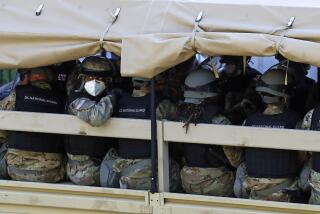Pentagon Panel Urges Small Joint-Service Strike Units
- Share via
WASHINGTON — A high-level advisory panel is urging the Pentagon to begin a sweeping transformation of the military by creating joint-service strike forces that could gain a foothold in international trouble spots in a single day.
A report written for Defense Secretary Donald H. Rumsfeld and released Tuesday called for these “global joint response forces” to deploy air armadas, missiles, naval forces and other troops to gain control of war zones within four days. They would be organized to achieve victory in 30 days.
Retired Air Force Gen. James McCarthy, chairman of the study committee, said the new forces would be the first phase of a plan to remake the entire military into an organization that is more lethal, more nimble and smaller.
The new units would be used “to act decisively before the facts on the ground become more difficult to change,” McCarthy said.
The committee’s dramatic proposal is one of a number of recommendations that have been offered to Rumsfeld by more than 20 study panels that he organized earlier this year to help him consider the needs of the military in the 21st century.
Although the McCarthy “transformation” panel is an admired group of former officers and experts, McCarthy said their recommendations represented “inputs” to Rumsfeld rather than a plan that the Defense secretary necessarily intends to use.
Rumsfeld has emphasized in recent weeks that the panels’ work is intended to help shape his thinking but may not be the basis for any sweeping reorganization.
Many of the ingredients in the committee’s plan have appeared again and again in the recipes for change that have been put forth by experts in recent years. Most of these proposals have stressed increasing the force’s need for speed, stealth, long reach and the use of highly integrated networks of computers and sensors.
McCarthy said the committee was not recommending a radical redesign of military units but a reorganization of units as they exist now, through closer integration of the military services.
“We are not talking about a new force.” The concern, McCarthy said, “is how to organize and exercise and train the existing forces, and what capabilities to give them.”
He said that, while the services have made strides in working together in combat theaters, they need to go further.
“The services are very, very capable, but they still have not learned, and they have not trained, and have not exercised sufficiently for us to claim we have a true joint-force capability,” he said.
Although Bush administration officials have suggested that the forces have been overused in recent years for peacekeeping and humanitarian missions, the committee’s plan gives central emphasis to those kinds of deployments.
It calls for creation of a special organization for humanitarian operations. And it would give high priority in defense planning to limited military operations, such as the 1999 air war against Yugoslavia.
The committee did not offer any budget estimates or any timeline for its proposed reorganization.
However, the panel made several recommendations on major weapon programs. It called for speeding up deployment of the Navy’s version of the proposed joint strike fighter aircraft.
The fighter, which is due to enter service in 2008, should be accelerated by two or three years, McCarthy said. The panel urged this, he said, because the planes would add radar-evading stealth capabilities to seaborne air power.
In the panel’s view, a proposed destroyer, the DD-21, and a new aircraft carrier should be put on a back burner.
The panel had other recommendations aimed at supplementing the firepower of the armed forces.
To increase the number of precision-guided weapons it can deliver, the military should convert four Ohio-class submarines to carry cruise missiles instead of nuclear ballistic missiles.
The committee called for modification of the Air Force’s fleet of 21 bat-winged B-2 bombers so that the long-range stealth aircraft could carry a greater number and broader variety of bombs. The panel also urged that the military either buy new B-2s or develop new manned or unmanned bombers, McCarthy said.
The committee also urged accelerating the production of the high-flying Global Hawk unmanned spy plane. And though it made no judgment on the technical problems that confront the Marine’s hybrid V-22 tilt-rotor aircraft, the panel did judge the Osprey to be a “transformational technology,” McCarthy said.
More to Read
Sign up for Essential California
The most important California stories and recommendations in your inbox every morning.
You may occasionally receive promotional content from the Los Angeles Times.











